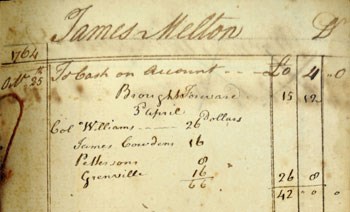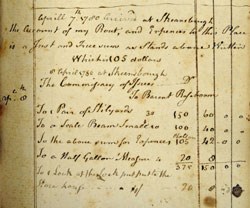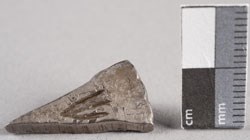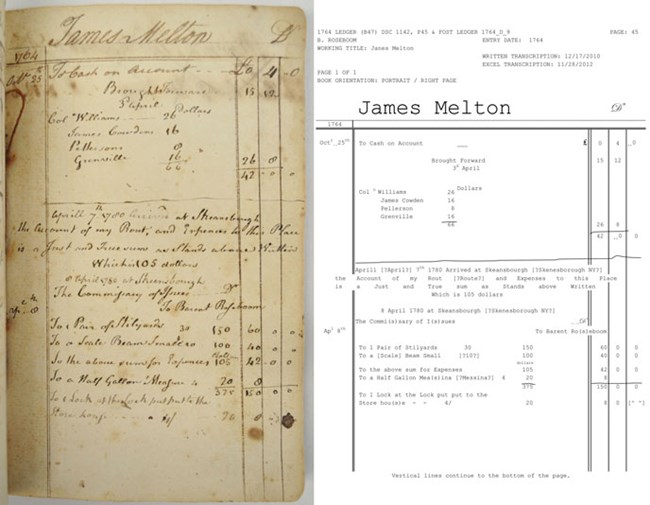
NPS image. This page from the Barent Roseboom book details two separate debit transactions with James Melton. These entries occurred on different dates and, most likely, at different locations. The first shows that James Melton was loaned cash on October 25, 1764, which was paid to four individuals on his behalf. Merchants sometimes loaned money to third parties. Whoever was keeping this book at the time, paid Colonel Williams, James Cowden, Pellerson, and Grenville on behalf of Melton with the understanding that the original loan was to be repaid by James Melton. 
NPS image. The second entry details transaction on April 7th and 8th in 1780 (16 years after the first entry!). On these dates, Barent Roseboom received a pair of stilyards, a scale, a half-gallon Messina, and a lock from the storehouse. The stilyards and the scale beam would have been important in the business of trade and were used to weigh trade items like sugar or chocolate. These weighing instruments were likely brought to Skenesborough, NY from England. Within this entry, the "Half Gallon of Messina," probably refers to lemon juice. Lemons and other citrus were grown near Messina, Italy during the 18th century. During this time, evidence was gaining that citrus juice, which contains Vitamin C, provided protection from scurvy. By 1795, lemon juice was included with rations in the British Navy (Baron 2009). Lemon juice was also sometimes added to the rum or grog rations given to soldiers. Book Keeping The transactions recorded in the first entry illustrate a 'triangular payment' where three parties were involved in loaning and settling debt. Colonel Williams, James Cowden, Pellerson, and Grenville were paid money on behalf of James Melton. James Melton incurred the debt and would be responsible for paying Barent Roseboom the money given to these four individuals. Essentially, instead of having debt with numerous individuals, James Melton consolidated his debt with Barent Roseboom. 
NPS image. Detailed within these entries is the monetary conversion of dollars to pounds, shillings and pence. Spanish dollars were the unofficial currency of the colonies during the 18th century. Colonists trusted this coinage because it was made from silver. Making change with the Spanish dollars was also easy since dollars were cut into "pieces of eight" or eight bits. Early attempts to make coins in the United States began in 1783 with the first official coinage adopted in 1787 (Federal Reserve of Philadelphia). 
NPS image. Further Questions As with all entries in the Roseboom ledgers, more questions emerge as the texts are transcribed. A few of the questions that left us puzzled relate to the objects and the relationships of those listed on the page. One such question that will likely remain unanswered is: what was the relationship between James Melton and Colonel Williams, James Cowden, Pellerson, and Grenville? On April 8th, 1780, James Melton received a lock "put to the store house". Who's storehouse is being referred to in this description? Where these directions for Melton or is an 18th century description of a specific type of lock typically used to secure storehouses? Finally, we know that Skenesborough was a popular town that held supplies for traders, merchants, and the general public. Where in Skenesborough did these transactions between Barent Roseboom and James Melton take place? Works Cited
Baron, Jeremy Hugh
2009 Sailors' Scurvy Before and After James Lind –a Reassessment. Nutrition Reviews, 67(6): 315-332.
Federal Reserve of Philadelphia
2015 Money in Colonial Times, Colonial Coins. Accessed 8/27/2015.
Explore the Roseboom Ledgers John Fluno and John Dillebaugh Settlement with Major William Hogan Resources |
Last updated: October 4, 2017
